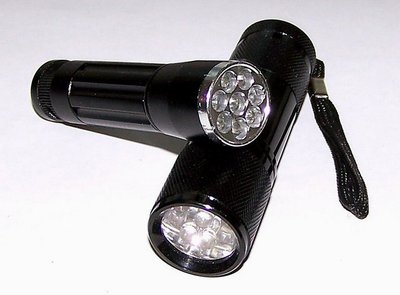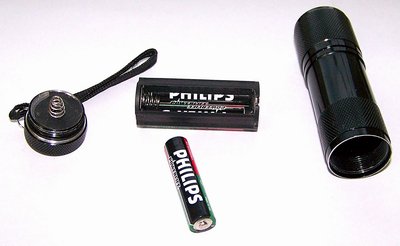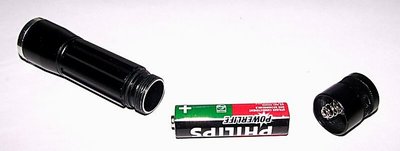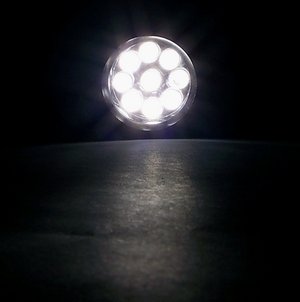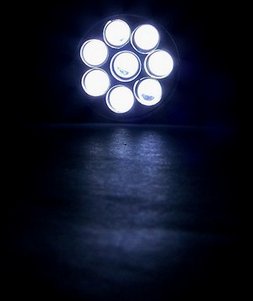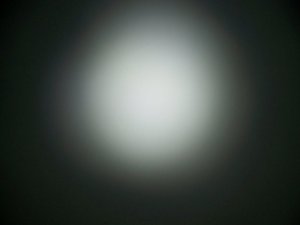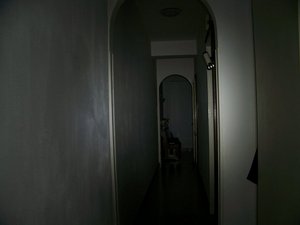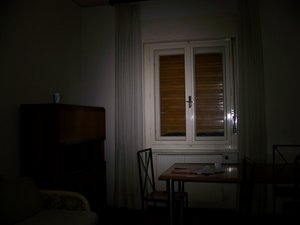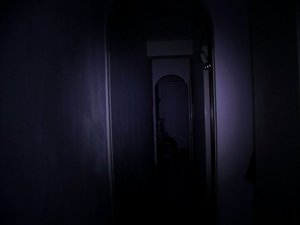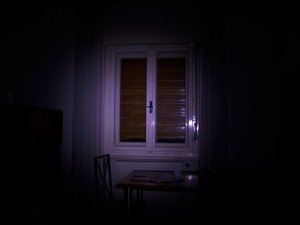TechNFun - Fun with technology
Electronic gadgets reviewed and modified
Reviewed on:
25th January 2008
Cheap LED flashlights
9-LED 3-AAA and 8-LED 1-AA flashlights
I like LED flashlights.
They are efficient, small, practical and bright.
They are also no longer a niche product for enthusiasts or professionals.
A few years ago all the portable lights that department stores carried were incandescents. Most people didn't even know there were others, and those who did know often didn't care.
Those who did care were the early adopters who, as always, ended up paying lots of money for products that weren't really all that impressive. Not that many of them didn't have good reasons to do so, but the deal still wasn't very tempting (as was the case with so many other technologies).
Fast forward to today and we have LED lights in department stores, house lighting and even security and military use.
Heck, Maglite are making LED flashlights. That's almost like saying Harley-Davidson are making light, efficient and practical motorbikes.
Go to the local electronics store, though, and prices are still likely to be higher than they should be. It's not uncommon to pay several decabucks for lights that are unremarkable in any way except for their use of "innovative" LEDs. They are often made of plastic, easy to break, creaky and cheap-feeling.
How to do, then, if you want modern LED flashlights that don't cost much but don't feel like they'll come apart if you look at them too hard?
Ah, thereby hangs a tale (and several reviews).
Hidden in the arcane mists of the net, there exists a magical place known as DealExtreme (not much of a name for a magical place, I grant you, but still). Through sacred rituals and prayers to the Great Gods, the inhabitants of DealExtreme gained access to a magical device that can create matter out of thin air, and are thus able to sell vast amounts of electronic gadgets for incredibly little money.
Well, I don't know how their prices could be explained otherwise. That's my story and I'm sticking to it.
As if that wasn't enough, all their prices are comprehensive of shipping to anywhere in the world.
I suspect magical teleportation portals may be involved.
Inbetween the mind-boggling vastness of their stock there are many flashlights.
Like these:
The 8-LED is the smaller one resting itself on top of the 9-LED.
Let's examine them more closely.
Chinese shops often sell lights that are similar to this one. I know because I bought two in the past.
One still works, but it's quite dim and the tailcap will separate in its component parts if I unscrew it and don't keep it together with my hand.
The other one worked for a few hours, and it was pretty bright, but then the LEDs started dying, and then it fell apart.
The DealExtreme flashlight is better than that.
It doesn't fall apart. It feels solid, the metal is thick and its internals are fit in place strongly enough that nothing rattles.
It's also bright. DealExtreme originally sold a version with common-or-garden bluish-white LEDs, but they've since upgraded it with newer-generation 20.000 mcd LEDs, which are brighter and whiter.
And it's very, very cheap. $5.23 buys you a two-pack.
The body is partially knurled for better grip, but it's also perfectly round, which poses a bit of a problem: if you place the 9-LED on any even gently sloping surface, it'll promptly roll away and probably fall on the ground.
Which is unlikely to damage the light, mind you, but you don't want it to happen while you're working on an active electric substation or something.
There's a hole for a lanyard in the side of the tailcap. The stock lanyard is connected to the light with a small metal ring, which helps with the rolling issue; not by much, as the 9-LED with batteries in it is on the heavy side and might just slide off anyway, but every little bit helps.
The switch is on the back of the tailcap, and is a so-called "reverse clicky". This means that you press it down and it clicks, then you release it and the light turns on. The other kind of switch is the "forward clicky", which turns the light on before clicking and locks in the on position after the click.
Flashlights equipped with forward clickies are capable of momentary activation without clicking at all. This is called "tactical" operation, as it's meant to be used for quick flashes of perpetrator-revealing light.
Reverse clickies can do momentary-off (you click it on, then depress the switch enough that the light switches off but not enough that it clicks again; stop pressing and the light turns back on), but that's rarely of any usefulness.
Many flashlight enthusiasts are often sold on one type of switch, and some will religiously avoid the other. Not being a soldier or security officer, and therefore not needing tactical functions, I don't care.
The switch is stiff enough that it's unlikely to turn on accidentally without being too stiff for comfortable operation. The best way to hold the light is the "tactical" one, with your fist around it and your thumb resting on the switch (yes, the word "tactical" gets thrown around a lot in the flashlight world). Holding it inbetween the index and middle finger is doable, but the light's thickness makes it impractical.
One more thing about the switch: every now and then during testing, the flashlight dimmed a bit while flickering a bit. I think it's the switch's fault, as switching it off and on a few times seems to cure the problem. Giving it a good whack also seems to cure the problem, and it never stayed dim after being whacked, so I don't consider this a serious offense.
Still, if you foresee finding yourself in a situation where your life depends on your flashlight turning on at full power NOW, you probably want a light with a switch that costs more than $0.02 or thereabouts.
The 9-LED has no sealing o-rings. It can withstand sprinkling, but water will easily flood it if you dunk it. It has no water-sensitive electronics inside, though, so if you drown it all you have to do is clean it, replace the batteries and it should resume working just fine.
You can tail-stand it for candle mode - setting it down upright so that it illuminates the ceiling and by reflection the rest of the room - but the rubber surface of the switch rises beyond the metal tailcap and causes the flashlight to never point straight up. Note that if you have the stock lanyard on you can't tail-stand it, as the metal ring causes it to fall over.
Funkier lights have a double-circuit resistored design that lets you have two modes, with one being dimmer for more battery life. Even funkier lights are fully microcontroller-regulated, and may have up to twenty modes.
That's not always a good thing. I don't know about you, but I don't want to have to search for a bloody walkthrough to operate a flashlight.
You don't get any of that at this price, though. The 9-LED is a single-stage flashlight - a fancy way of saying "on and off".
What if you want to run a flashlight from a single commonly available, decently grunty AA cell?
LEDs aren't like incandescent bulbs; you can't just get a white LED made to run from a lower voltage, simply because all white LEDs require a minimum of 3.3 volts to give any output to speak of, and really want about 3.6V for full power. The precise voltage depends on the LED type, with some wanting a voltage as high as 4.2, but the bare minimum is still more than three volts.
So you stick a boost converter in your flashlight that allows it to drive the LEDs with more voltage than its single AA cell could give by itself.
Simple boost converters are cheap and plentiful, so equipping a light with one doesn't drive its price up much: the 8-LED only costs $3.22.
Its choice of battery makes it much thinner than the 9-LED light, so it's adequate as an EDC flashlight. It's bright enough for light duty general-purpose use (reading menus in dimly lit clubs, finding that screw that just fell behind the desk, walking around your home during a blackout...) without being so bright that it causes you to damage your night vision if you happen to shine it on a nearby wall.
The light I got uses eight ordinary LEDs that are definitely not top-of-the-line, efficiency-wise. They do their job, but their beams are sort of bluish, and not terribly bright.
DealExtreme have updated the product page since I got the 8-LED. It now says "Improved version for better built and LED brightness" [sic], which probably means they've changed LED type. I don't know what they're using right now, but it's possible they are the same 20000mcd LEDs the 9-LED uses, which would give the new models a welcome increase in brightness.
The 8-LED feels very tough. It doesn't rattle or creak, the body is solid and the LEDs have a tough metal ring protecting them.
It too has a tendency to roll away, and it too can be prevented from doing so with a metal ring on the lanyard hole.
The flashlight has a small o-ring on the tail, but none on the head. I presume its purpose is just to make it smoother to turn the tailcap, as the light is definitely not waterproof.
The switching mechanism is a twistie: you turn it on by screwing down the tailcap (which is slightly knurled to facilitate operation) and off by unscrewing it a bit. Keep unscrewing and the tailcap will come off and let you replace the battery.
You can also keep the tailcap always screwed on and twistie-operate the head, but I advise against it. The tailcap is rather regular
in its operation: it always switches on at the same point, it switches off as soon as you start unscrewing it and it lets you do momentary
tactical bursts if you unscrew it just enough to switch off and then push on it.
The head, instead, needs to be unscrewed almost a full turn before it'll switch off, and even then it's unreliable and doesn't feel very smooth.
By the way, this particular flashlight connects with the battery with a simple point contact on the head and a spring contact on the tailcap. I've received reports that other lights functionally identical to this one (apparently called "Xnova") have the contacts inverted. I presume the head-tailcap twistie operation is reversed for those.
The tailcap is, for reasons unclear, a bit convex. This bugs me, because it prevents using the flashlight in candle mode. I don't think there's anything in the tailcap that justifies this shape, so I guess one could sand or grind the convex part off if one really cared about candle mode. The result would be rather ugly, though, unless done with care and painted.
The light I got was a bit flickery, and rarely lit at the same brightness twice in a row. After giving it some thought I figured the problem was in some paint that had dribbled down to the edge of the battery tube. Enthusiastically scrubbing both ends of the tube on some sandpaper solved the problem.
The 9-LED flashlight runs from three AAA cells that you insert in a standard carrier, as seen in umpteen cheap lights.
It has voltage signs on it to stop you from putting it in the wrong way around, but nothing bad will happen if you do.
Alkalines are ok if you want long battery life at the expense of brightness. I measured power consumption with a carrier-full of alkaline AAAs, and from fresh cells it started at about 600 milliamps, dropping the voltage from 4.6 volts to 3.7.
That's about 67 milliamps per LED. Standard white LEDs normally run at a maximum of about 40 milliamps, so 67 is a serious overdrive factor. Overdriving LEDs causes them to be brighter, but efficiency goes down and the oft-quoted 100.000 hours bulb life is reduced.
Alkalines, however, won't give them so much current for long.
Standard alkaline AA cells are ok at draws up to about 250 milliamps, and aren't too bad at 300. Standard alkalines AAAs, on the other hand, start seriously sweating at about 100ma. Draw more than that out of them and you're beating them senseless. Draw 600 mA and you're viciously torturing them.
Under such a high draw they'll overheat, their voltage will sag and they won't be able to deliver anything like 600 mA mere minutes after power-on. In a simple circuit such as this, however, lower voltage also means lower current draw, so they'll soldier on at reduced output for quite a while.
What all this means is that the 9-LED flashlight is startlingly bright from fresh cells, but doesn't stay that way for long. After a few minutes the cells lose steam and you get a progressively dimmer beam that's likely to last for several hours. And the LEDs are only significantly overdriven for a few minutes every time you change the cells, so they are likely to last long enough that you'll never have to worry about them.
This also means that I can't draw a neat line and tell you how long fresh cells last, as it depends on how dim a light you're willing to put up with.
If any light is good light, you might be able to run the 9-LED for more than a straight day from the same cells. It'll be barely bright enough to notice in the end, but it won't stop producing light for a surprisingly long time.
Rechargeable cells are different.
They have low internal resistance, which means they are fine delivering much, much higher currents than alkalines can manage. They have lower initial voltage (1.2v nominal against the 1.5v nominal of alkalines), which can give problems in low-power applications that aren't explicitly meant to use them, but their voltage won't sag significantly under anything but awfully high loads.
They also have a pretty flat discharge curve. An alkaline's voltage will go down as its charge is depleted, whereas a rechargeable will stay close to its rated voltage during most of its charge, slumping down rather quickly only at the end.
NiMH cells used to have high self discharge - if they sat on the shelf for a month they could be almost discharged when you eventually tried to use them - but that problem's been cured in recent times by LSD cells.
You can now take a minute to get all the psychoactive-related jokes out of your system.
Three 800mah LSD NiMH cells in the 9-LED's carrier give about 3.6v in use, and the flashlight draws about 480ma from them. The behaviour of NiMH cells makes the maths much more straightforward in this case: each led sees about 50 milliamps all the time, and the flashlight will stay at or close to full brightness for about an hour and a half, maybe a bit more, then the output will decrease quickly and the cells will have to be recharged.
A hour and a half is much less than the useful runtime you get with alkalines, but for most of those two hours the flashlight will be considerably brighter.
Lithium primary AAAs fit in the carrier, but are not a good idea. This is because the 9-LED is unresistored. The LED assembly is connected straight to the batteries, and the high current draw is expected to decrease voltage enough that no harm is likely to be done.
Lithium AAAs have a higher nominal voltage (1.7V) and can withstand high draws better than alkalines, so three of them will have a 5.1 unloaded voltage that won't sag much under load and will kill those LEDs fast.
The 8-LED flashlight draws about 420 milliamps from a fresh alkaline, and 350 from a NiMH cell. But that's from one cell, not three, so it's effectively eating less than a third of the power of the 9-LED. Since a part of that power is eaten by the inevitable inefficiency in its boost circuit, it's clear that its emitters are driven much more gently.
A draw of 420 mA is rather mean to an alkaline AA, but an AA in this light is still much better off than the AAAs in the 9-LED. Accordingly, you should get three to four hours of close to full brightness followed by many more at progressively dimmer output.
The converter in the 8-LED is good at getting every last bit of energy out of alkaline cells. I have an old AA that reads 0.8V open-circuit (practically flat), but when I fed it to the 8-LED it still worked. It was much dimmer, but in a pinch a dim light is a lot better than no light at all. Current draw was only 25ma, by the way.
DealExtreme put a carbon-zinc "dry" cell (actual market value approximating zero) in the flashlight before they send it to you. The 8-LED's ability to run well at reduced level means you can power it with carbon-zincs and get non-useless runtime, but you should still only use them if you have nothing better available.
Again, the numbers are clearer with NiMH rechargeables: assuming the use of a 2000mah LSD cell, you should get about five hours at close to full power followed by a few minutes of quickly dimming light.
You can use lithium primary AAs in the 8-LED for slightly higher brightness and a bit more battery life; the boost circuit is perfectly able to handle the slightly increased voltage.
Do not, however, use lithium-ion 14500-size cells; the boost circuit is very unlikely to be able to handle the 3.7 volts nominal and would probably quickly release the magic smoke.
All pictures here were taken with the flashlights running on fresh alkaline cells.
Looking straight at the emitters, this is how they appear (9-LED left, 8-LED right, not to scale):
The pictures are taller than they need to be for the sole reason that I find the reflection of the beams on the paper pretty to look at.
What follows are beamshots of the lights illuminating a white wall at a distance of one metre, my house's corridor and my living room. I made them by fiddling with shutter speed, aperture, white balance and sensitivity in such a way that the result appears as similar as possible to what my eyes see. I'm shortsighted, but my light sensitivity is as average as it gets, so I believe they are decent representations of how the beams actually look.
Here's the 3-AAA's beam:
As you can see, it's rather whiter than that of many 5mm LED flashlights. Those 20000mcd LEDs are pretty good.
It's also quite floody, as is always the case with lights running multiple 5mm emitters. This means it's excellent for seeing where you're going or working in dark places, but it's no good if you need to illuminate a particular target at a distance.
Here's how it looks in real-life use:
The 8-LED light's output is rather less impressive:
Less bright, less floody and rather bluer. It's immediately apparent that the emitters used are the old generation type, and not driven terribly hard.
Still useful, but not as powerful.
Flashlights running from 3AAA carriers are good candidates for a LiIon battery swap, as most will happily run from a single 18500 cell. In this particular flashlight, however, I advise against using LiIons.
A LiIon cell will deliver a voltage of about 4.2V when fully charged, and it won't sag significantly under load. This causes current draw to shoot up, and the LEDs to suffer.
I connected a 18500 cell just long enough to check the numbers. Current draw was about 850ma, which is close to 100ma per LED, or about 2.5 times the maximum driving current they expect to see.
There are 5mm LEDs meant to withstand ferocious overdriving without dying too soon, and some are built to accept 100ma as their standard driving current (by using four or five dies in one package), but you don't get either at this price. Had I kept the 18500 connected for any significant length of time, LEDs would have probably started dying.
I could have soldered in an appropriate resistor somewhere on the LED board; that would have allowed me to run the light on the 18500 with no worries and with considerably better runtime when compared to AAAs. However, since I a) have plenty of NiMH AAAs around, and b) don't have the appropriate resistor, I decided to leave the 9-LED as it is.
One could also swap even better LEDs in place of the 20000mcd ones (there are some rated at a whopping 55000mcd), but I don't have any (yet), so I didn't do that.
I wanted to swap 20000mcd LEDs in the 8-LED flashlight, though, so I tried taking the head apart. It can't be unscrewed from the back, so it must be held in place by the shiny metal ring in front.
The problem is the metal ring won't come off.
I'm not sure what they used to glue it in place, but it's strong enough stuff that it's not bothered by pliers, tongs and even chisels. Heating the ring with a butane torch didn't help.
As you can imagine, attempting to brute-force the ring off caused all sorts of aesthetic damage. I now have a flashlight that looks as if it's gone through a jet engine, but is stubbornly still in one piece.
Oh, and it still works as if it was new, despite having been subjected to countless hammer and chisel blows, some given in frustration and strong enough to wake up my cat two rooms away.
The 9-LED is a decent flashlight. Its beam is surprisingly bright, its floody pool of light makes it perfect for general use and it's decently built.
It's not the most reliable light in the world, and I'm not sure how much abuse it can withstand before starting to seriously misbehave, but it beats the pants off the nasty hypercheap incandescent flashlights that get sold in supermarkets the world over, and heaven knows a lot of people buy those.
It lacks any regulation whatsoever and it's not small enough for EDC duty, but it's incredibly cheap. If you'd normally go for supermarket cheapo-lights, get a few of these instead. You'll be glad you did.
I liked the 1-AA 8-LED a lot. It could have better LEDs (newer ones probably do), and it's quite a lot dimmer than the 9-LED, but it's still bright enough for many purposes, it has very good battery life and it'll give useful light from almost-dead cells.
It's also very small: if you want something to EDC for as little money as possible, the 8-LED is definitely a good candidate, as long as you don't expect it to let you clearly see anything that's more than a few metres away.
And it's practically immortal. I'm not sure what kind of physical damage one would have to apply in order to break it, but I'm pretty sure the owner would not survive the experience. Maybe if you shot it out of a spud gun you could manage to, I dunno, slightly dent it or something.
At $3.22 it's a steal. Buy one. Or seven.
